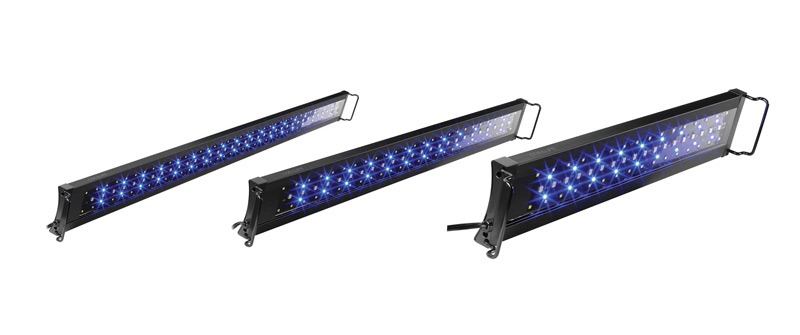The Coralife LED Aqualight S is a new striplight from the veteran brand of aquarium products. The LED Aqualight S is virtually identical to the Aqueon Optibright Plus in form factor and remote control, but with a different spectrum of LEDs under the hood to make it more suitable for saltwater tanks.
The LED Aqualight S is available from Coralife in three sizes, a 24 inch model for $99, a 36 inch model for $115 and the longest is 48 inches long and costs $135. Coralife claims that the new LED Aqualight S is suitable for growing low to medium light corals and plants with the intensity peaking out at about 40 umols of PAR at a depth of 12 inches.
Like the Aqueon Optibright Plus, the LED Aqualight S has three channels of LEDs in several colors. One channel is dedicated to a bank of bright white LEDs, another one is loaded up with moonlight-level blue LEDs and lastly, the RGB channel is actually three channels in one for fine tuning the overall color rendition of the LED Aqualight S.

With the same pedigree as Aqueon’s Optibright, the biggest new feature that the Coralife LED Aqualight S inherits is that highly useful remote control. The remote control for the Coralife LED Aqualight S allows wireless adjustments of each channels brightness level, the color of the RGB LEDs, but most importantly it has the same access to the built-in three channel timer so you don’t have to buy anything else to make the light do your bidding.
With the reef aquarium hobby being in love with blue light, it’s a pity that the LED Aqualight S doesn’t have more of a blue-heavy light spectrum; sure the blue moonlight channel and the RGB both have a smattering of blue but probably not enough to really balance out the brightness of the white LEDs. It’s somewhat odd that there’s no mention of what the overall wattage is of any of these LED striplights but at least the listed PAR values for this striplight does seem to indicate that it will be a good light for beginners and low light saltwater and reef aquariums.




